Ranked: the 63 GREATEST chocolate bars of all time
Is your favourite on the list?

Photo_Pix/Shutterstock
Chocolate bars in all their guises have been satisfying the world's sweet teeth for centuries. But which one would you reach for ahead of all others? In honour of a timeless treat that's beloved around the globe, here we reveal the world’s best chocolate bars. From famous names sold internationally to lost (but not forgotten) gems no longer available, read on to see if your favourite made the list.
Read on to discover the world’s best chocolate bars, counting down to the tastiest of all time.
Our ranking is based on the popularity of each chocolate bar, taking into account sales, longevity and the reaction of the products at their time of release. The list is unavoidably subjective.
63: Dars, Japan

ANIS SURIANI/Shutterstock
Brought to life in 1993 by Japanese brand Morinaga & Co., which has been producing chocolate for over a century, Dars is one of Japan’s bestselling chocolate brands. Defined by its smooth surface and melt-in-the-mouth qualities, each packet is stuffed with bitesize pieces. What’s more, it comes in a variety of flavours, including milk chocolate, white, dark chocolate and green tea.
62: Yankie, Denmark

TomsDanmark/Facebook
The Yankie was invented in 1946 in Denmark, after Toms International was asked by the US army (positioned in Germany at the time) to produce a bar that would appeal to American soldiers. As a nod to its Danish origin, the bar was deliberately misspelled Yankie, rather than the American Yankee. The sweet treat features a rich caramel and creamy nougat filling, finished with a milk chocolate coating.
61: Darrell Lea Chocolate Blocks, various locations

DarrellLeaAus/Facebook
This family favourite has been a part of Australia’s chocolate culture since the late 1920s, but it wasn’t until 2019 that the brand introduced its delicious Blocks range. Since then, it's become one of the chocolatier’s most popular options, complete with tasty flavours like Rocklea Road and Caramel Snows. The brand is now loved in the US, too, known best for its liquorice range.
60: Butlers Salted Almond & Butterscotch, Ireland

butlerschocolate/Facebook
Famed Irish chocolatier Butlers has been making its sweet treats since 1932 and its delicious flavour combinations continue to keep fans satisfied. The Salted Almond & Butterscotch bar is a crowd favourite and one of the brand’s bestsellers. The sharing pack comes complete with a creamy white chocolate base, with almond flakes and crispy butterscotch laced throughout.
59: Bubu Lulu, Mexico and USA

TheCX/Flickr/CC BY-NC-ND 2.0
One of Mexico’s most popular bars, Bubu Lulu features a sweet strawberry and gooey marshmallow filling, finished with a silky milk chocolate coating. It was first introduced in 1978 by Barcel, the snack brand behind Takis, and has gone on to become a beloved snack for kids. While it’s not widely available in the US, you can often find it in Mexican stores and international supermarkets.
58: Mr. Big, various locations
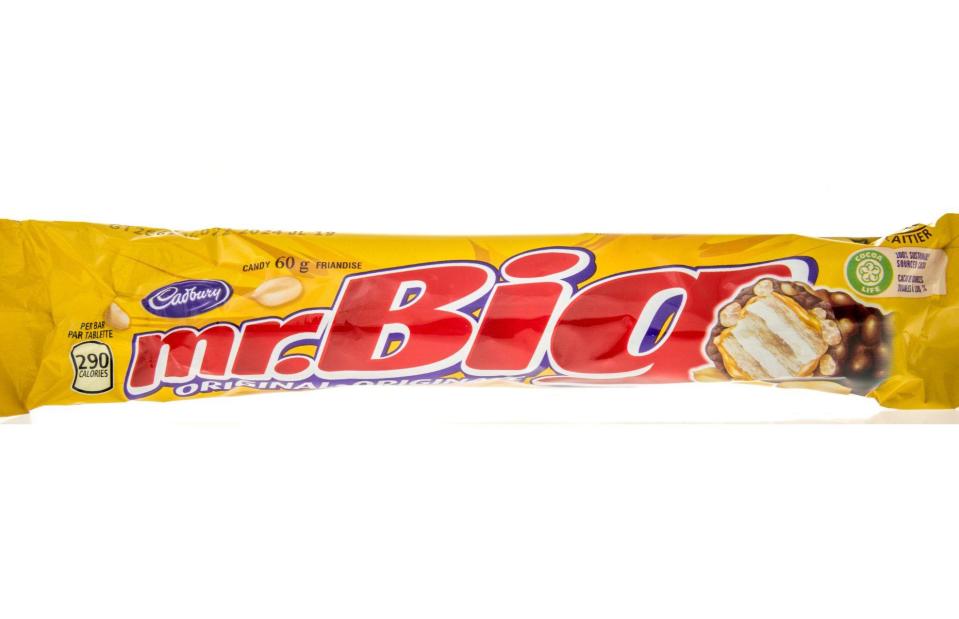
Keith Homan/Shutterstock
First launched in Canada in 1979, Mr. Big is a scrumptious bar consisting of vanilla wafer biscuits covered with caramel, peanuts and rice crisps and finished with a delicate coating of chocolate. The product landed in US markets in 1995, with a fun advertisement campaign featuring basketball player Shaquille O’Neal. Nowadays, you can still find it in Canada, the US and some European countries.
57: Tres Sueños, Argentina

cadburyargentina/Facebook
Produced by Cadbury in Argentina, this delicious bar features three layers of chocolate: a milk chocolate bottom, white chocolate centre and a dark chocolate top. The bar – wrapped inside the brand’s signature purple packaging – is super smooth and blends all three chocolate flavours together beautifully. Here’s hoping this treat makes its way around the globe soon.
56: Alpia Alpine Milk, Germany

Imago/Alamy Stock Photo
Chocolatiers since 1906, Alpia is a German company renowned for its creamy consistency, smooth finish and delicious chocolate flavours. As the name suggests, the brand draws inspiration from the Alps, with different segments of the bar designed to look like mountain peaks. Its Alpine Milk option is a crowd favourite thanks to its distinct melt-in-the-mouth texture. Alpia comes in a range of other styles, too, including hazelnut, dark chocolate and raisins and nuts.
55: Meiji Milk Chocolate, various locations

Walter Eric Sy/Shutterstock
ThisJapanese brand has been around for almost a century and is now loved in countries including Thailand and China, thanks to its high cocoa content and creamy, milky characteristics. The classic Meiji Milk Chocolate, available individually wrapped, cubed or in block format, is a firm favourite. You can get almonds and biscuit sticks coated in the signature chocolate, too.
54: Tosca, Australia

Bycroft Boy/Flickr/CC BY-NC-SA 2.0
Who remembers this chocolatey treat? Available in Australia, this sweet bar was produced by Rowntree’s and featured layers of cream, caramel and wafer, all smothered with a coating of milk chocolate. It graced supermarket shelves for a few decades before being discontinued in the 1990s.
53: Can’t Get Knafeh of It, UAE

Fix-Dessert-Chocolatier/Facebook
Having gone viral on social media, Dubai-based Fix Dessert Chocolatier lives up to the hype. Famed for bars with a melty middle and snappable exterior, the brand launched in 2021 and has since gone on to release a line of mouth-watering filled bars. The standout, though, is the Can’t Get Knafeh of It, a chocolatey take on the sweet Arabic dessert made with kataifi (shredded filo pastry). Snap it open and its green-hued pistachio, tahini and crunchy kataifi paste oozes out. Available exclusively in Dubai, it’s well worth trying if you’re lucky enough to get your hands on a bar.
52: Huesitos, Spain

Imago/Alamy Stock Photo
This popular bar is enjoyed across Spain and is known for being utterly moreish. It features a crispy wafer and chocolate cream filling, encased in a delicious milk chocolate coating. It was first introduced to Spanish markets in 1975, before being bought by Cadbury-Schweppes in the late 1980s. Now produced by Chocolates Valor, the bar has become such a Spanish staple it’s even been a limited-edition McFlurry topping.
51: Reggie!, USA

Make It Old/Flickr/CC BY-NC-SA 2.0
Named after the New York Yankee player Reggie Jackson, this chocolate bar was filled with rich caramel and roasted peanuts and coated with milk chocolate. Available in the US between 1978 and 1981, it wasn’t around for very long but did garner quite a cult following. You can sometimes find old bars selling on eBay for a small fortune.
50: Skor Bar, Canada and USA

Keith Homan/Shutterstock
Produced by The Hershey Company, this bar is made up of a thin, crisp, butter toffee centre and is coated with a layer of milk chocolate. Despite being initially set up to compete with Heath (number 35 on our list), Hershey's acquired the rival chocolate in 1996 and continues to sell both bars.
49: Time Out, various locations

Like_the_Grand_Canyon/Flickr/CC BY-NC 2.0
Produced by Cadbury, each Time Out pack was filled with two wafer fingers covered in chocolate. The bar initially launched in the UK and Ireland in 1992, before being released in Canada a decade later. Much to fans' dismay, it was taken off shelves in 2016 and replaced with the Time Out Wafer, a single version with significantly less chocolate.
48: Poulain Chocolat Noir Extra, France

PA Images/Alamy Stock Photo
One of the world’s oldest chocolate brands, Poulain first launched in France in 1848 and has gone on to become renowned for both its cooking and eating bars. The company, briefly owned by Cadbury and currently produced by Carambar, offers a delectable Noir Extra range. Ultra rich and slightly bitter, it’s perfect for enjoying by the square or incorporating into baking recipes.
47: Seven Up, USA

pearsonscandy/Instagram
Can you remember this unusual bar? Brought to life by Pearson’s in the 1930s, the Seven Up featured seven different chocolate flavours and styles, all sandwiched inside one bar. The combination varied over the years, including everything from butterscotch and caramel to coconut and mint. Understandably, it was a complicated bar to produce and was discontinued in 1979.
46: Chomp, various locations

Keith Homan/Shutterstock
A nostalgic choice, the Chomp is bound to bring childhood memories flooding back for some. First manufactured in South Africa in the early 1970s, this bar is also available in Australia and the UK, though its style changes depending on location. The Australian bar is made with layers of wafer and caramel wrapped in a chocolate coating, while the UK version has a chewy caramel centre with chocolate on the outside.
45: Almond Joy, USA

Keith Homan/Shutterstock
Do you prefer a classic Mounds bar or an Almond Joy? Produced by Hershey’s, this coconut-centred bar is almost identical to its older sibling Mounds – though, it comes packaged inside a rich blue wrapper, rather than a red one – and was launched two decades later, in 1946. Aside from its wrapper, the only difference is that it’s topped with almonds before being coated in dreamy milk chocolate. It’s also arguably more popular – and better known around the world – than the red-wrapped Mounds.
44: Oh Henry!, Canada and USA

Keith Homan/Shutterstock
Renowned for its bright yellow packaging, this tasty treat was first produced by the William Candy Company in 1920, and features a caramel-nougat centre with peanuts and is coated in milk chocolate. This beloved chocolate bar may have been discontinued in the US since 2019, but it lives on in Canada, albeit with a slightly different recipe.
43: Curly Wurly, various locations

Rachel Husband/Alamy Stock Photo
First launching in the UK in 1970, the Curly Wurly has stood the test of time and remains a nostalgic treat enjoyed by many. Super chewy and delicious, this Cadbury bar features a rich caramel that’s encased in milk chocolate. It was made by chance, when researcher David John Parfitt began experimenting with leftover toffee at the Cadbury factory. It’s now sold in many countries, including Australia, Austria, Canada and Germany.
42: Scorched Peanut Bar, Australia

cooksconfectionery.com.au/Facebook
Anyone who has spent any time in Australia will no doubt recognise this delicious toffee-laced, peanut-based bar. Its history stretches back to 1928, when confectionery brand Mastercraft first launched it in Australian markets. By the 1960s it was one of the country’s most popular bars, though it was sadly discontinued in 2000 due to lack of sales. Thankfully, Cooks Confectionery went on to revive it in 2019. Complete with its original packaging design, fans can now get their hands on the sugary sweet bar once again.
41: Guylian Original Praliné, various locations

SS Studios/Alamy Stock Photo
This Belgian brand is known for its shell and seahorse–shaped chocolates, so when it launched its Original Praliné bar, topped with the cute decorations, fans went wild. Made with convenience in mind, this luxury on-the-go version was an instant hit. The centre has a bubbly texture, while the chocolate itself has a subtle hazelnut flavour.
40: Crunch, various locations

Keith Homan/Shutterstock
Introduced to the US market by Nestlé in 1938, this milk chocolate and crisped rice bar has gone on to be sold across the globe, landing on UK shelves in 1965. Though it’s similar to Hershey’s Krackel bar, it continues to sell just as well and remains a popular choice for children and adults alike.
39: Picnic, various locations

Rachel Husband/Alamy Stock Photo
Packed out with chewy caramel, cereal pieces, juicy raisins and crunchy peanuts and finished with a milk chocolate coating, the Picnic bar joined the Cadbury community in 1959. Over six decades later and it’s loved across the globe for its interesting texture and flavourful filling. Limited-edition versions have launched over the years, including Picnic Honeycomb and Picnic Rocky Road.
38: Dream, various locations
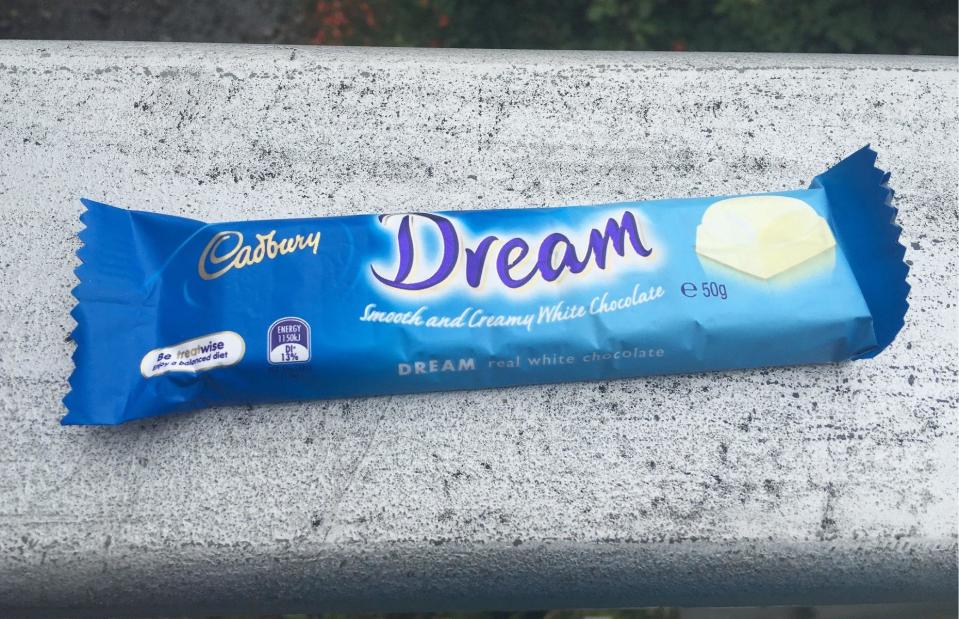
Like_the_Grand_Canyon/Flickr/CC BY-NC 2.0
Lovers of white chocolate adore this creamy creation from Cadbury. Dream first launched in Australia and New Zealand in 2001, quickly becoming a popular alternative to a bar of classic Dairy Milk. It landed in Canada and the UK a year later, but has since been withdrawn from UK markets, despite protests from fans. It has made brief returns over the years, but UK white chocolate devotees are still eagerly awaiting its permanent reintroduction.
37: Yorkie, UK

urbanbuzz/Shutterstock
The Yorkie came to the UK in 1976 and was originally produced by York-based confectionery company Rowntree’s. This chunky milk chocolate bar was famously heavily marketed towards men, and over the years, there have been many divisive, masculine-led advertising campaigns, including the 2002 ‘It’s Not For Girls!’ slogan. Thankfully, the team finally dropped all references in 2011. Other Yorkie flavours include a popular Raisin & Biscuit option.
36: Mr. Goodbar, USA

Sheila Fitzgerald/Shutterstock
One bar that’s stood the test of time is Mr. Goodbar. Complete with roasted peanuts and creamy milk chocolate, this continues to be one of Hershey’s bestsellers almost a century after its release, and it’s easy to see why: its nutty flavour is delicious. During the Great Depression, the brand had to rethink its sales strategy to avoid losing customers completely and, as a result, positioned the product as a protein-packed meal due to its peanut content. The strategy worked and the bar remains on the market today.
35: Heath, USA

Keith Homan/Shutterstock
Created by the Heath family in their small, family-run confectionary shop in Robinson, Illinois, this tasty bar first launched in the late 1920s. The bar – featuring crunchy toffee and milk chocolate – continues to be a popular choice across the US almost a century later. It went on to inspire many rival bars, including Daim and Skor. Hershey’s took over the brand in 1996.
34: Tony’s Chocolonely, various locations

Grzegorz Czapski/Shutterstock
Known for its brightly wrapped bars and fair-trade efforts, Tony’s Chocolonely is a brand with a conscience. Founded in 2005 by Dutch TV producer and journalist Teun van de Keuken, the company set out to raise awareness surrounding slavery within the cocoa industry and is on a mission to end it completely. Since initially launching in the Netherlands, the brand now has a 20% share of the Dutch chocolate bar market and is available in many countries across the globe, including Germany, the UK and the US.
33: Schogetten Alpine Milk Chocolate, Germany

TanyaLovus/Shutterstock
Landing on German supermarket shelves in 1962, Schogetten has been a go-to choice ever since and it’s easy to see why. Thousands of its products are produced each day, all using premium raw materials and carefully selected ingredients to create the brand’s signature creamy blend. From Caramel Brownie to Crunchy Peanut Butter, there are a host of great styles available, but it’s the Alpine Milk Chocolate that’s kept fans coming back for more since day one.
32: Butterfinger, USA

Wendy van Overstreet/Shutterstock
Launched by Curtiss Candy Company in 1923, this ‘crispety, crunchety, peanut-buttery’ bar has been on supermarket shelves for over a century and continues to deliver on deliciousness. Coated in chocolate, it boasts a honeycomb, peanut and caramel centre. The bar, now owned by Nestlé, has had some brilliant – and hilarious – marketing campaigns over the years, including being promoted in the 1934 film Baby Take a Bow and by characters from The Simpsons during the 1990s.
31: Animal Bar, UK

Medicimage Education/Alamy Stock Photo
A popular choice for kids growing up in the UK, this milk chocolate treat came complete with a game printed on the inside of the colourful packaging and a chirpy animal moulded into the bar itself. First released in 1963 by Nestlé, it proved a hit for six decades before finally being discontinued in 2023.
30: Ritter Sport Alpine Milk Chocolate, various locations

tastyfood/Shutterstock
Designed to slide inside any sports jacket pocket, this bar first debuted in Germany in 1932. Made with 100% milk from the Alps, each bar is presented inside a colourfully designed wrapper and comes in an assortment of flavours, from macadamia and cashew to marzipan and orange.
29: Cadbury Fruit & Nut, various locations
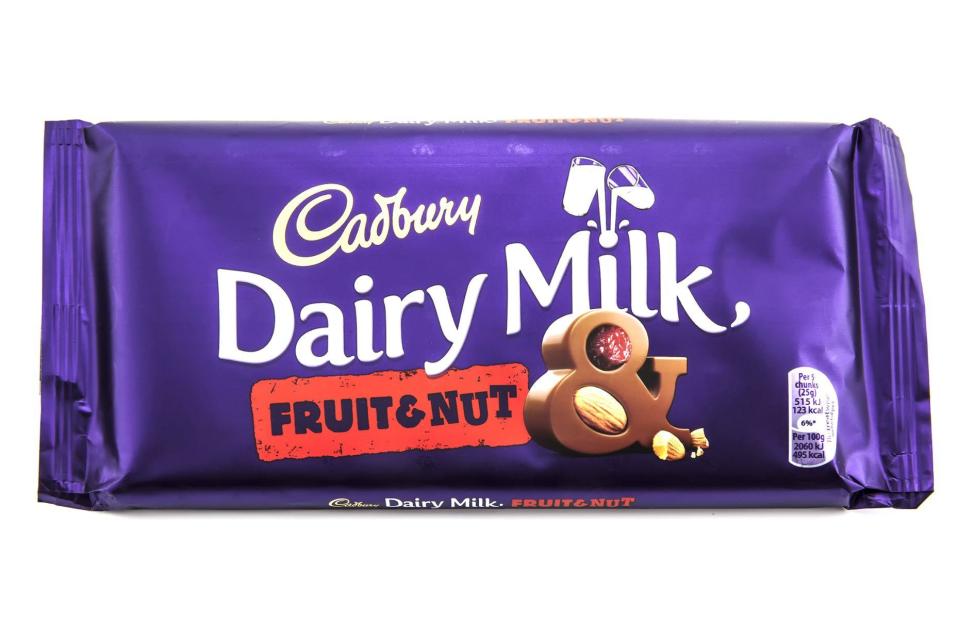
urbanbuzz/Shutterstock
While this bar may have fallen out of fashion with younger generations in recent years, Cadbury Fruit & Nut is more than worthy of a mention due to its longevity. The bar first appeared in 1926, combining classic Dairy Milk chocolate with a mix of juicy raisins and chunky almonds. Just four years later, the brand released the Whole Nut bar, laced with hazelnuts.
28: Bournville, various locations

yackers1/Shutterstock
Bournville – named after the model village in Birmingham, England that was built for Cadbury workers – has been a vital part of the Cadbury brand since the early 1900s. Known for its dark flavour, the first product to enter the UK market was Bournville Cocoa powder in 1906, quickly followed by the now-renowned Bournville Dark Chocolate bar in 1908. Today, this bar is typically used in baking and makes a great after-dinner treat.
27: Lion, various locations

page frederique/Shutterstock
The Lion bar – featuring layers of wafer, caramel and cereals covered with milk chocolate – was first launched in 1976 by Rowntree’s. Now owned by Nestlé, the bar is famed for its signature lion mascot and is enjoyed in countries across Europe. In 2004, the bar was rebranded to target teenagers and the recipe changed significantly, with only the wafer remaining untouched. Despite this, it’s still a popular choice today.
26: Toblerone, various locations

Wachiwit/Shutterstock
This Swiss bar landed on shelves in 1908 and quickly became a hit thanks to its distinctive mountain-like shape and sweet honey and nougat–laced chocolate. By 1969, a dark chocolate iteration was introduced, and over the years further fun flavours have launched, including Orange Twist and Crunchy Almonds & Salted Caramel. With its gold and red wrapper, Toblerone is, of course, a staple of airport duty-free shops.
25: Lindt Lindor Milk Chocolate Bar, various locations

chrisdorney/Shutterstock
Producing chocolate delights since 1845, Lindt has been at the top of its game for almost two centuries. From its foil-wrapped bunnies to its indulgent truffle selection, this Swiss brand has garnered a reputation for its silky smooth, velvety texture. So, when the brand released its Lindt Lindor Milk Chocolate Bar, it was sure to be a success. Drawing inspiration from the brand’s first Lindor solid bars from 1949, this item allowed fans to enjoy Lindt’s signature chocolate in a delicious, personal-sized format.
24: Polly Waffle, Australia

menzfruchocs/Facebook
Another Australian favourite, the Polly Waffle was invented in 1947 by Melbourne-based Hoadley’s Chocolate. Featuring a blend of wafer, marshmallow and creamy chocolate, the product sadly didn’t stand the test of time, with Nestlé discontinuing it in 2009. But much to fans delight, Menz Confectionery bought the rights and began producing the treat in a new bitesize format in April 2024.
23: Aero, various locations

SilgeAO/Shutterstock
A bar that has benefited from its distinctive, aerated centre, Aero was first launched in the UK by Rowntree’s in 1935. While it had a bumpy start (it was discontinued for almost a decade due to Second World War rationing), the popular brand persevered and went on to produce Aero Peppermint in 1959 and Aero Orange in 1960. These days, more than eight million Aero products are sold annually in the UK alone (amounting to four million bubbles created daily, according to the brand).
22: Bounty, various locations

razorpix/Alamy Stock Photo
It's fair to say people either love or hate the Bounty. The sweet, coconut-centred bar was first introduced to UK and Canadian markets in 1951 and has gone on to become a global success. It’s similar to a Hershey's Mounds or Almond Joy bar and is no longer sold in the US domestically. A few flavour combinations have launched over the years, including a cherry option in Australia, which was available from 2006 to 2013.
21: Caramac, UK and Ireland

Photo_Pix/Shutterstock
Although not technically a chocolate bar (it doesn’t contain any cocoa), it would be remiss to miss the beloved Caramac off this world’s best list. Renowned for its signature red and yellow wrapper, the bar made its debut in the UK in 1959; sales declined over the years and, in late 2023, Nestlé announced it would be axing the caramel-flavoured treat for good. That said, the bar has such a dedicated following it has already resurfaced for a limited-edition run.
20: Flake, various locations

Rachel Husband/Alamy Stock Photo
One of Cadbury’s most cherished creations, you can often find the Flake slotted into the top of an ice cream cone. Known for its crumbly texture, the bar initially launched in the UK over a century ago and is now enjoyed in many countries around the world, including Australia, Canada and the US. It was made by complete chance, when factory workers noticed the ovens were covered in sheets of fine, flaky chocolate after use.
19: Galaxy, various locations

chrisdorney/Shutterstock
Galaxy, known as Dove in the US and some parts of Europe, has become one of the world’s bestselling chocolate bars. The brand first launched in the UK in 1960, quickly garnering a reputation for its silky-smooth texture. Owned by Mars, the brand has gone on to release some tasty varieties, including a vegan range which launched in 2019.
18: Crunchie, various locations

chrisdorney/Shutterstock
Encased in a shimmering gold and purple wrapper, the Crunchie is hard to beat. Each packet is filled with a crispy honeycomb toffee centre, all coated with a layer of milk chocolate. This chewy concoction made its debut in the UK in 1929 and has since gone on to be sold around the world, including several European countries, Australia, Canada, New Zealand and South Africa.
17: Milkybar, various locations

milkybar/Facebook
Another popular choice that evokes memories from childhood, the Milkybar has been a part of chocolate culture since Nestlé launched it way back in 1936. Though not sold in the US, this creamy white chocolate bar became renowned for its friendly mascot, the Milkybar Kid. The young blond child has been part of the branding since 1961, brought to life in animated and live-action TV ads.
16: Daim, various locations

SophieOst/Shutterstock
First produced in Sweden in the 1950s, this popular bar features a hard, almond-caramel centre coated in a smooth milk chocolate. The product initially launched with the name Dajm in Sweden and Norway, before rebranding in 1990 when its global popularity grew – Daim was deemed easier to pronounce. Nowadays, you can find this bar across Australia, Europe, Japan and more.
15: Cherry Ripe, Australia and New Zealand
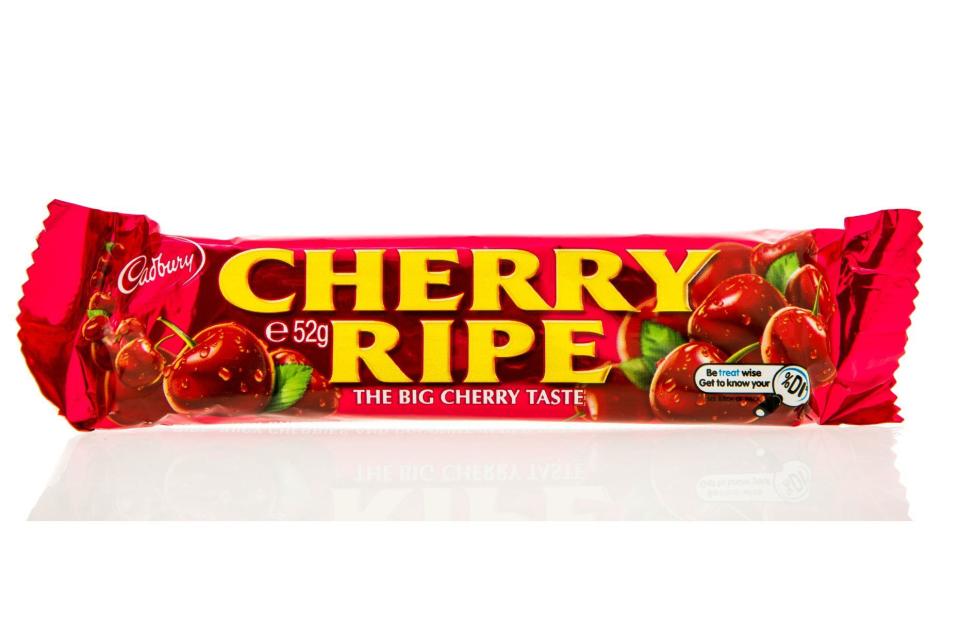
Keith Homan/Shutterstock
Launched by Australian confectionery company MacRobertson’s in 1924, this super-sweet treat is one of the country’s oldest chocolate bars. Still enjoyed across Australia and New Zealand today, it features a tasty blend of cherries and coconut, all wrapped in rich dark chocolate. Now owned by Cadbury, the product comes in a few variations, including a double-dipped option and an ice cream style.
14: Fry’s Chocolate Cream, UK and Ireland

Antiques & Collectables/Alamy Stock Photo
Dating as far back as 1866, Fry’s Chocolate Cream was the first mass-produced filled bar in the world, created by British chocolatiers, J. S. Fry & Sons. With its signature blue and white wrapper, the original bar featured a plain fondant centre encased in simple dark chocolate. The popular Orange Cream and Peppermint Cream flavours launched in 1934.
13: Milky Way, various locations

Abramova Elena/Shutterstock
First produced by Mars in 1924, there are actually two versions of this popular treat. The US Milky Way (also available in Canada) features a nougat centre, finished with a caramel top and milk chocolate coating. Elsewhere, the classic Milky Way is almost identical, minus the caramel topping. This global variation is sold as a 3 Musketeers bar in Canada and the US.
12: Kinder Bueno, various locations

Abramova Elena/Shutterstock
An integral part of the Kinder Chocolate brand, this delicious treat was first introduced in Germany and Italy in the early 1990s, quickly becoming a global sensation enjoyed in around 60 countries. Each packet comes complete with two wafer fingers, packed with hazelnut cream and drizzled with a milk chocolate coating. Nowadays, the style is available in a range of flavours, including coconut, white and dark chocolate.
11: Wispa, various locations

Rachel Husband/Alamy Stock Photo
Launched by Cadbury in the UK in 1981, this chocolatey treat differentiates itself from a classic chocolate bar. In fact, fans think its unique, aerated texture is so irreplaceable that they campaigned for its return – and succeeded – after Cadbury initially discontinued the product in 2003. There have been a few flavours released over the years, including mint, orange and strawberry.
10: Reese’s Peanut Butter Cups, various locations

karen roach/Shutterstock
Bridging the gap between sweet and savoury, Reese’s Peanut Butter Cups have been an American household staple for almost a century. The treats – featuring peanut butter encased in chocolate – were invented by dairy farmer H. B. Reese in 1928. From day dot, he used Hershey's chocolate to coat the filling, so it was only a matter of time before the confectionary giant bought the product, merging with the H. B. Reese Candy Company in 1963. Though some purists might argue it's not technically a bar, the Big Cup is equally satisfying.
9: Freddo, various locations

chrisdorney/Shutterstock
How much did a Freddo cost when you were growing up? This popular frog-shaped choc has been a part of many childhoods since it first launched in Australia in 1930. Originally produced by Australian chocolate company MacRobertson’s, the bar has since joined the Cadbury family. Over the years, there have been a few iterations and flavours, including Caramello Koala (previously Caramello Bear), a popular choice in Australia.
8: Twix, various locations

Shyripa Alexandr/Shutterstock
The iconic Twix bar – featuring two biscuit fingers with caramel and a milk chocolate coating – landed on UK supermarket shelves in 1967, before launching in the US in 1979. Produced by Mars, the bar was named Raider in mainland Europe until 1991. Several additional flavours have launched in recent years, from Salted Caramel to Cookies & Crème, while the original Twix remains hugely popular to this day.
7: Twirl, various locations
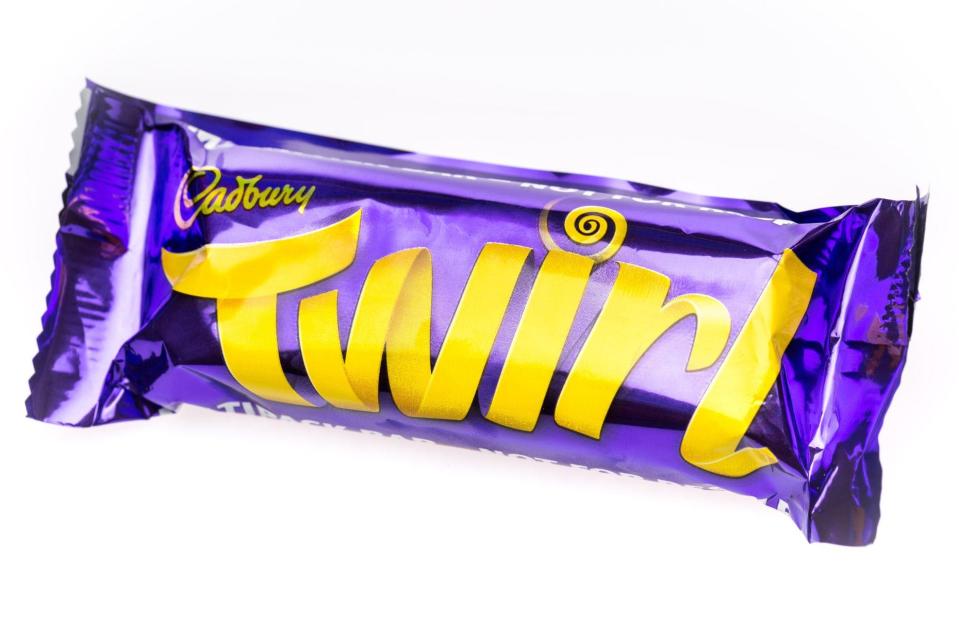
True Images/Alamy Stock Photo
A smoother take on Cadbury’s popular Flake, the Twirl features a crumbly flaked centre covered in a milk chocolate casing. Invented at a Cadbury factory in Dublin in the 1980s, it initially launched as a single-finger bar, becoming the two-finger pack we know and love today two years later. In 2019, Cadbury launched a limited-edition, orange-flavoured variety that was so popular it became a permanent fixture. Two additional flavours, caramel and mint, have since been released.
6: KitKat, various locations

jennywonderland/Shutterstock
Defined by its signature two- and four-finger bars and snappy catchphrase – 'have a break, have a KitKat' – these bars debuted in the UK in 1935. Originally owned by Rowntree's, the popular brand is now globally produced by Nestlé (apart from in the US, where it’s made under licence by Hershey’s). Over the decades, KitKat has garnered a reputation for its interesting flavour combinations, from cappuccino to watermelon, and continues to be one of the most innovative chocolate bar brands in the world.
5: Milka, various locations

WDnet Creation/Shutterstock
Delighting chocolate lovers around the world since 1901, Milka is instantly recognisable thanks to its signature lilac wrapper. The classic bar was first launched in Lörrach, Germany by Swiss chocolatier Philippe Suchard. The brand, now owned by Mondelez International, continues to use Alpine milk chocolate and has become renowned for its indulgently milky flavour. Another airport staple, it’s estimated 150,000 Milka products are sold every hour worldwide.
4: Hershey’s Milk Chocolate, various locations

AlenKadr/Shutterstock
This deliciously sweet bar has been a part of American culture since it first launched in 1900. A lot of trial and error went into creating this classic bar, but the result was worth it, and it has become the legendary candy manufacturer’s flagship product. Following a successful launch, Hershey's began experimenting with flavour combinations, with Hershey’s Milk Chocolate with Almonds coming out eight years later. Although a quintessentially American chocolate, this bar and other variations are now enjoyed globally.
3: Mars, various locations

AlenKadr/Shutterstock
Creator Forrest Mars Sr had no idea what an impact he would have on chocolate culture when he first launched the Mars bar in 1932. Created in Slough, England, the bar has since gone on to earn a global reputation for its sticky nougat and caramel layers and crisp milk chocolate coating. In the US, Mars’ Milky Way is almost exactly the same as this bar. The classic Mars comes in various forms these days, from bitesize Planets to Mars Frozen Dessert Bars.
2: Dairy Milk, various locations

Tony Smith/Alamy Stock Photo
The original bar produced by Cadbury, Dairy Milk has been a British household staple since 1905. Armed with its signature purple wrapping, it’s defined by its silky, creamy finish. These days, the product comes in a variety of formats and is enjoyed worldwide. In the US, it’s produced under licence by Hershey's to a slightly adapted recipe. Regardless, it’s still one of the bestselling – and best-loved – bars in the world.
1: Snickers, various locations

Shyripa Alexandr/Shutterstock
Rich with nougat, peanut and caramel, this chocolate treat is the world’s bestselling bar. Produced by Mars, Snickers first launched in the US in 1930, named after the Mars family’s horse. The brand later expanded to the UK and Ireland in 1968, under the name Marathon, before changing its name in 1990 to align with the global brand identity. Nowadays, you can find these bars sold around the world.


